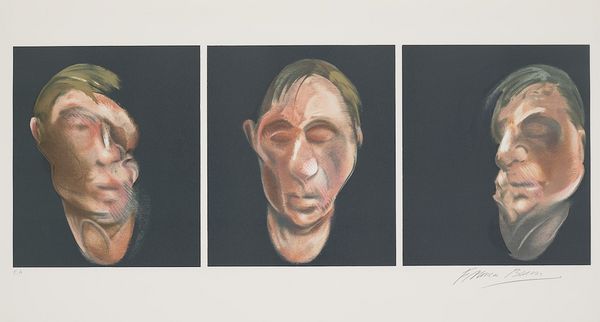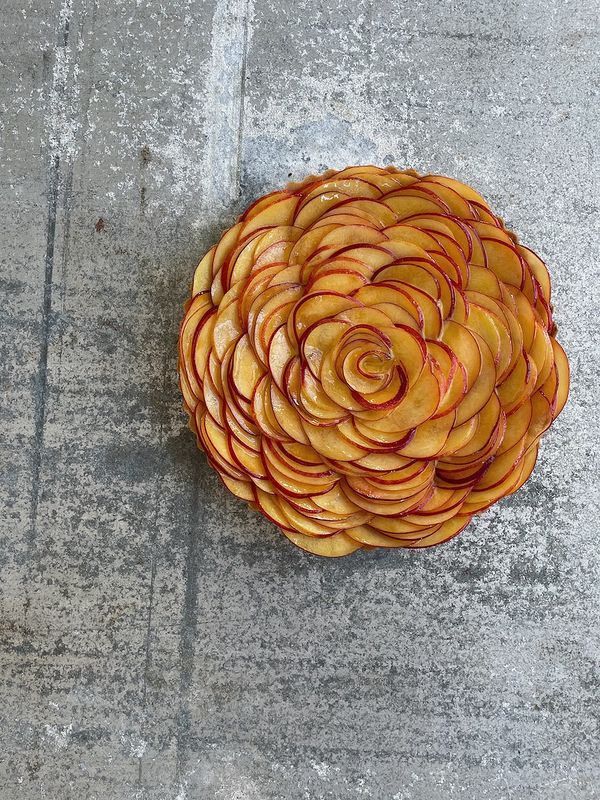Food styling by Imogen Kwok.
Written and imagined by Imogen Kwok
The following dishes invite you to experience the editions in our upcoming London auction from a unique, culinary perspective. The concept and technique of four artists’ works have been re-interpreted through ingredients and cooking methods—bringing these artworks to the plate.
Roy Lichtenstein
Roy Lichtenstein, Reflections on Girl, from Reflections Series (C. 245), 1990. Estimate £50,000 - 70,000. Evening & Day Editions London.
Roy Lichtenstein’s Reflection Series focuses on the obscurity of vision and transparency, influenced by the artist’s experience photographing a Rauschenberg print that had been laid out under glass.
The contrast in texture between these two gelatin desserts explores this idea of light and perception, reflection and mirroring; the translucency of the brightly colored fruit jellies is set against the opaqueness of the milky coconut panna cotta.
The use of gelatin, as the integral ingredient of both desserts, plays off Lichtenstein’s imagery of a stylized blond beauty from 1960s comics in Reflections on Girl. Trembling jello dishes were an iconic dessert of the mid-century dinner table, often manipulated into ornate shapes by being set in elaborate molds. Refrigerators were still an expensive novelty at the time—as gelatin requires refrigeration to properly set, they were a culinary trend designed to impress.
Food styling by Imogen Kwok.
COCONUT PANNA COTTA AND FRUIT JUICE JELLIES
Yield: 8 servings
Ingredients
For the coconut panna cotta:
80ml cool water
2 teaspoons gelatin powder
1 400ml can coconut cream, well shaken
120g caster sugar
For the fruit juice jellies:
80ml cool water
2 teaspoons gelatin powder
400ml variation cold-pressed fruit juice, such as apple, carrot or orange
120g caster sugar
For the topping:
30g caster sugar
5-6 kumquats, thinly sliced
Maldon salt
Method
For the coconut panna cotta:
- Pour the water in a small bowl and sprinkle over the gelatin powder. Let sit for 10-15 minutes until the gelatin has softened and the mixture has thickened.
- Combine the coconut cream and sugar in a small saucepan and set over medium high heat, whisking constantly until the sugar has completely dissolved. Let cool (if the liquid is too hot then the gelatin will not set properly) then pour in the softened gelatin mixture and stir.
- Set 4 ramekins (each 3 inches in diameter, 1 1/2 inches deep) on a sheet tray and pour the panna cotta liquid evenly into each one.
- Refrigerate overnight to set.
For the fruit juice jellies:
- Pour the water in a small bowl and sprinkle over the gelatin powder. Let sit for 10-15 minutes until the gelatin has softened and the mixture has thickened.
- Combine the juice and half of the sugar in a small saucepan and set over medium high heat, whisking constantly until the sugar has completely dissolved. Taste and add more sugar if necessary (depending on the juice, you may not need to add more).
- Let cool (if the liquid is too hot then the gelatin will not set properly) then pour in the softened gelatin mixture and stir.
- Set 4 ramekins (each 3 inches in diameter, 1 1/2 inches deep) on a sheet tray and pour the panna cotta liquid evenly into each one.
- Refrigerate overnight to set.
For the topping:
- Combine the sugar and 30ml water in a small saucepan over low heat. Bring to a simmer, whisking briskly until the sugar has completed dissolved to make a simple syrup. Add the kumquat slices and continue to simmer for ~10 minutes until the kumquats have soaked up the syrup and have softened slightly.
- Remove from the heat and let cool.
Plating:
- To help release the desserts from their molds, prepare a shallow pan of warm water. Dip the bottom of each mold into the water (take care not to let any water seep on top of the panna cotta or jellies) for just a few seconds to loosen the vacuum between the gelatin mixture and the sides of the mold.
- Turn out the set desserts onto a sheet tray or wide serving platter. Top each with a spoonful of the kumquat topping, a pinch of salt for balance and enjoy both together.
Francis Bacon
Francis Bacon, Trois études pour un autoportrait (after, Three Studies for a Self- Portrait 1983), 1990. Estimate £15,000 - 20,000. Evening & Day Editions London.
Francis Bacon’s self-portraits have a haunting intensity and introspective quality verging on self-destruction—the artist is quoted as saying, “I loathe my own face...I’ve done a lot of self- portraits, really because people have been dying around me like flies.” Echoing this psychological state, this recipe uses natural clay, an inherently volatile material. Although clay can withstand extreme heat, the finished product can be destroyed in an instant.
The method of encasing whole stuffed apples in clay before baking creates a dramatic presentation that captures the vulnerability and dark nature of Bacon’s Three Studies for a Self-Portrait. As the apples’ hardened exterior shells split apart, the softened flesh inside is revealed. The movement from the active opening and the fractured cracks of the clay recall Bacon’s treatment of his own face in the lithographs; Bacon emphasizes the distortion of the skin, which is twisted into almost the point of disfiguration from one panel to the next.
Food styling by Imogen Kwok.
CLAY-BAKED WHOLE APPLES
Yield: 6 servings
Ingredients
6 large apples
1 lemon
1 teaspoon fennel seeds
1 teaspoon coriander seeds
1/2 teaspoon green peppercorns
1 red onion, peeled and finely chopped 1 garlic glove, peeled and micro-planed
250g pork mince
40g dried cranberries, roughly chopped 4 fresh thyme sprigs, leaves removed
A splash or two of rose water
Maldon salt
Extra virgin olive oil
1.5kg natural white, oven-bake (kiln-safe) clay
Method
For the filling:
- In a large sauté pan set over low heat, toast the fennel, coriander seeds and green peppercorns. Transfer to a mortar and pestle, then crush. Set aside.
- Set the same pan over medium heat and add a couple glugs of the olive oil. Add the cut onion and garlic, season with salt and gently sauté, stirring often, until the onion is soft and translucent. Add the pork mince and crushed spice mixture then increase the heat slightly, letting the pork caramelize.
- Leave on the heat until just cooked through, deglazing with the rose water to release any browned bits that have stuck to the bottom of the pan. Tip into a bowl with the cranberries and thyme leaves—set aside to let cool.
For the apples:
Preheat oven to 232C (450F)
- Prepare the apples: use a paring knife to slice off the top of each apple, almost like you are removing a hat with the stem (reserve these for use later). Then use an apple corer to remove the seeds and insides, without poking through the skin and leaving the walls about 2cm thick.
- Fill the apples with the pork mixture then wrap each one tightly in parchment paper, making sure to cover the opening well. Secure the paper at the top of each by placing the reserved top of the apple into the opening, pushing the paper closed. Note: the paper will protect the apple from the clay (which is not for consumption).
- Between two pieces of parchment paper, roll out the 1/2 of the clay into a flat sheet, around 1.5cm thick. Divide into 6 rectangles and wrap each apple with the clay, using your fingers to mold and smooth out the clay around the sides, making sure there are no gaps or open spaces.
- Place the apples on a sheet tray and slide it into the preheated oven.
- Bake for 30 minutes until the clay shell has dried and hardened. The apple will steam inside the clay shell so that you can cut into it with little resistance and the pork mixture will be moist and juicy.
- Let the apples cool for 15 minutes then bring to the table and crack open with a rolling pin or hammer. Open each parchment package to reveal the baked apple inside.
NB: the clay is not edible
Andy Warhol
Andy Warhol, Campbell's Soup I (F. & S. 44-53, 1968. Estimate £600,000 - 900,000. Evening & Day Editions London.
This dish is an unexpected interpretation of Andy Warhol’s famous silkscreen printing technique, as seen in Campbell’s Soup I. Instead of literally translating its subject into a soup recipe, the culinary concept concentrates on Warhol’s fixation on precision and his use of mechanical methods of reproduction.
His process is reflected in the repeated, operational cooking actions of creating the tart’s layered topping, which uses a mandolin to thinly cut each nectarine into exact, half-moon slices. To emphasize the visual effect of serial repetition of a single image, the recipe calls for layering each slice meticulously onto the pastry cream base in a concentric circular pattern.
In the same way that Warhol revolutionized an everyday subject matter, arranging the fruit in this manner transforms it from its natural, recognizable form into one that is reminiscent of a machine’s rotating cogs.
Food styling by Imogen Kwok.
NECTARINE LAYERED TART
Yield: 8 servings
Ingredients
For the tart shell :
133g AP flour
50g granulated sugar
1/4 teaspoon kosher salt
113g cold, unsalted butter, cut into 1/2 inch cubes
1 large egg yolk
60ml ice water
20g room temperature butter for greasing the tart tin
For the pastry cream:
230ml whole milk
1 1-inch piece of ginger, peeled and cut into thick slices
57g caster sugar
15g corn flour
1/8 teaspoon fine salt
2 large eggs, yolks and white separated (save the whites for another recipe)
15g cold unsalted butter, cut into 1/2 inch cubes
For the topping:
4-5 nectarines
1 lemon
80g apricot jam or preserves
Method
For the tart shell:
Preheat oven to 190C (375F).
- In a food processor, combine the flour, sugar, salt and butter cubes then pulse until the butter is cut into coarse breadcrumbs.
- In a small bowl, whisk together the egg yolk and half of the ice water then add to the flour mixture, continuing to pulse until a crumbly dough comes together. Add more ice water, one tablespoon at a time, if necessary.
- Tip out onto a cool tabletop and use either a dough scraper or your hands to bring together the dough and fold it onto itself—knead just a few times (avoid touching it too much) until it stays together when a little bit is squeezed in your palm.
- Use a pastry brush to grease the bottom and walls of a 21cm fluted tart tin.
- Roll out the dough into a 1/8” thick circle, then lay it over the prepared tin. Press it gently into the bottom and walls of the tin.
- Dock the bottom of the dough with a fork then refrigerate for at least 45 minutes.
- Line the bottom of the prepared tin with a parchment paper circle, then fill with a layer of pie weights, uncooked dry rice or dry beans.
- Blind bake the crust for 15 minutes. Remove the parchment paper and weights and return to the oven, uncovered, for another 8-10 minutes until the crust is hard and golden brown.
- Set on a wire rack to cool completely before filling with the pastry cream.
For the pastry cream:
- In a medium saucepan, combine milk, and ginger. Heat the milk until it almost reaches a boiling point (but do not let the liquid boil) to infuse the ginger.
- Remove from heat and let steep for 30 minutes until it has cooled.
- In a medium sized bowl, combine the egg yolks, caster sugar and corn flour then whisk well for 1 minute until it is light and has become fluffy in volume.
- Strain the infused milk mixture through a fine mesh sieve into a spouted vessel to remove solids. Save the saucepan.
- In a steady stream, pour the infused milk into the egg mixture, whisking constantly until all of it has been added.
- Add both mixtures to the original, reserved saucepan and bring slowly to a boil, stirring occasionally, then reduce and simmer until it has thickened.
- Transfer the pastry cream to a clean bowl, let cool for a few minutes then cover with cling film so that the plastic is touching the surface. Refrigerate for 2 hours (you can prepare the nectarines during this time).
Assembling:
- Use a sharp knife to cut around each nectarine to remove its stone. Use a mandolin to carefully slice each half into thin rounds (about 3mm thick), then cut half again so each slice is a half moon. Place in a bowl and squeeze over juice of the lemon.
- Dollop the cold pastry cream with a large spoon into the tart shell base. Evenly distribute the cream with an off-set spatula, smoothing out so it is flat.
- Starting at the outer edge of the tart shell, place the nectarine slices onto the filled tart in a concentric circle, with the curved side facing outwards. Each slice should overlap with the previous one as you work your way into the center.
- Once you reach the center of the tart, use smaller slices to create a neat rose shape.
- Transfer the tart to the fridge while you prepare the glaze.
- Combine the apricot preserves and a splash of water in a small saucepan. Heat over low heat, stirring well until it has melted and thinned out. Strain through a fine mesh strainer into a clean bowl.
- Remove the tart from the fridge and use a pastry brush to gently pat the apricot glaze over the entire nectarine. The toppings should be glossy and luminous.
- Cut the finished tart into slices and enjoy.
Alex Katz
Alex Katz, Oona, from Black Dress, 2015. Estimate £10,000 - 15,000. Evening & Day Editions London.
Alex Katz’s screenprint, Oona, from Black Dress, has a striking presence from its clean lines and bold color palette. The following recipe responds to how this work shows a depth of expression through simplicity in presentation.
An elegant fillet represents the little black dress (here and in Katz’s larger series); its delicate cut imitating the figure’s pose as she leans against the frame. While modest in appearance, the technique behind it is a three-step process of flour, egg and crumb layers before a careful shallow-fry.
The work’s vivid colors are reflected in the accompanying salad: bright in appearance from the fresh citrus then zingy in taste from the acid of the pickled red onion and fresh jalapeños.
Food styling by Imogen Kwok.
PANKO-CRUMBED FISH WITH ORANGE SALAD
Yield: 4 servings
Ingredients
For the orange salad:
1 red onion
1/2 teaspoon granulated sugar
2 limes
2 oranges, peel and pith cut away then the flesh thinly sliced 2 jalapeños, cut into thin rounds
A small bunch of fresh cilantro, leaves picked
Maldon salt
Extra virgin olive oil
For the crumbed fish:
4 white-flesh fish, such as red mullet, either butterflied or cut into fillets *
3 large eggs
150g AP flour
125g panko (Japanese breadcrumbs)
Maldon salt
1/2 teaspoon ground white pepper
Neutral oil
2 limes, cut into cheeks
Method
For the salad:
- Peel the red onion then cut into thin rounds and place in a small bowl. Squeeze over the lime juice, add the granulated sugar, season with Maldon salt and toss well to combine. Set aside to let quick pickle for 10 minutes.
- Combine the prepared red onion, orange slices, jalapeños and cilantro in a medium bowl, then dress with a little olive oil and salt. Refrigerate so the flavors marinate while you cook the fish.
For the fish:
- Set up three plates shallow bowls, each wide enough to accommodate the fish when it is laid out flat.
- Flour goes onto the first plate. Crack the eggs into a small bowl and whisk well until blended. Pour the mixture onto the second plate. Panko goes into the third.
- Season each fish on both sides with salt and the ground white pepper. Dip one fish into the flour first, covering both sides well then tapping off the excess. Repeat this action with the egg mixture then the breadcrumbs— pressing them gently into the fish so they adhere well.
- Heat a large saucepan over medium heat and add enough oil to fully cover the bottom in a thin layer.
- When the oil shimmers, shallow fry the fish for 3 minutes on each side until the crust is golden brown, pressing down on the fish with a fish spatula to prevent it from curling up. Depending on the size of the pan you may have to do this in two batches—you do not want to crowd the pan. When the fish is done, set onto a wire rack-lined sheet tray, seasoning straight away with salt.
- Serve with the orange salad and a squeeze of fresh lime juice.
Imogen Kwok views food as more than a basic human necessity—she uses it as a visceral language to encourage comprehension through consumption. The intimate ritual of eating breaks down barriers, triggers emotional responses and imprints powerful memories.
Kwok lives and works in London, UK. She graduated with an MA in History of Art from the University of St. Andrews in St Andrews, Scotland. She holds a Grand Diplome from The French Culinary Institute in New York City, NY and has trained at Michelin-Starred restaurants such as Eleven Madison Park and Blue Hill Stone Barns.
Discover More from Evening & Day Editions >
Recommended Reading
Specialist Picks: Unlikely Pairings, from Joseph Beuys to Roy Lichtenstein >









